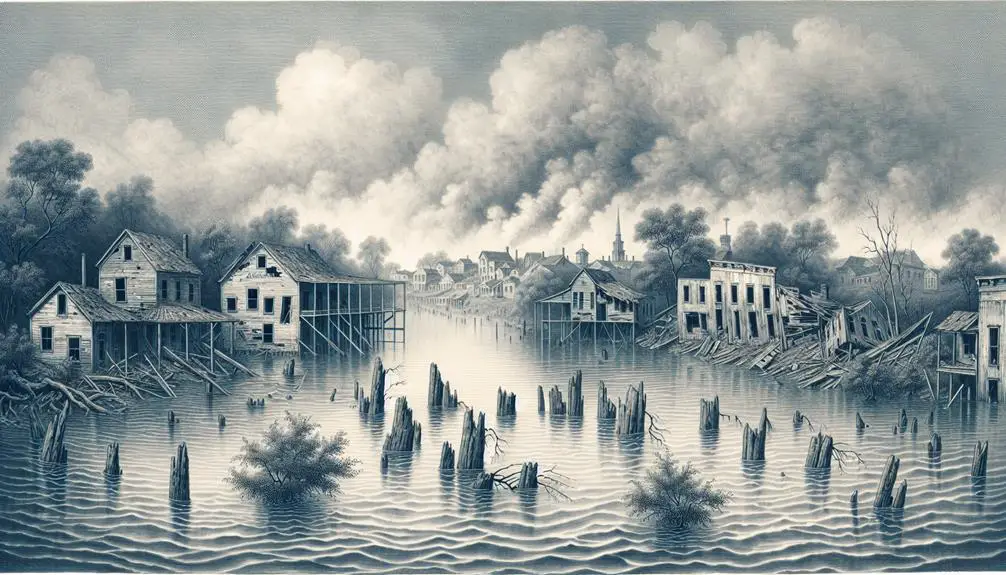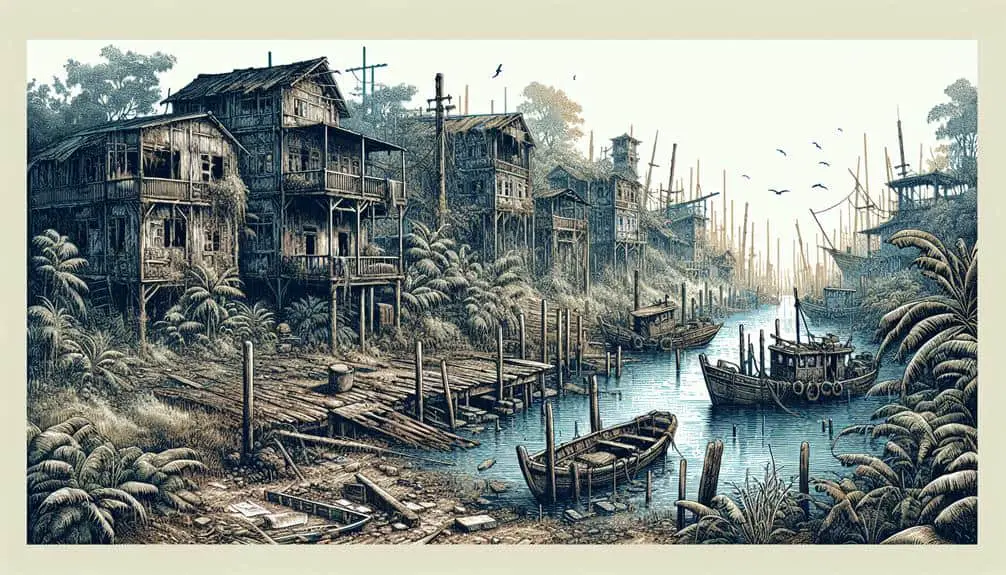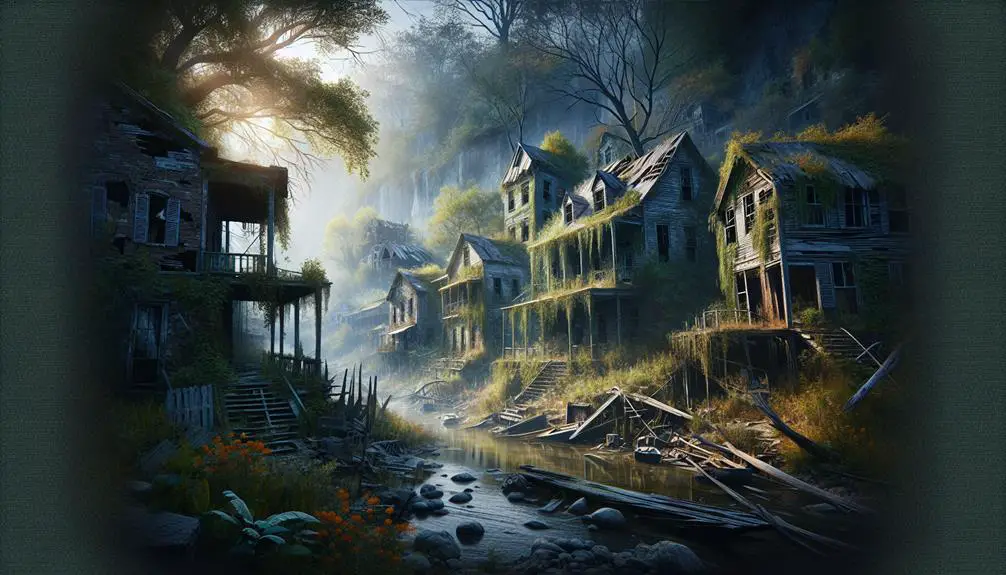Uncover the eerie charm of submerged ghost towns along US rivers. Rodney, Mississippi, showcases antebellum remnants. St. Thomas, Nevada, submerged by Lake Mead, reflects a frozen past. Columbia River's Celilo Village was a bustling trading hub. Twelvepole, West Virginia, boasts diverse artifacts waiting for exploration. Elbowoods, North Dakota, submerged by progress, echoes sacrifices made. Explore deeper into the haunting beauty of these towns frozen in time.
Key Points
- Rodney, Mississippi: Abandoned town along the Mississippi River with historic architecture and emerging wildlife habitats.
- St. Thomas, Nevada: Submerged ghost town in Lake Mead, frozen in time after Hoover Dam construction.
- Celilo Village, Oregon: Native American trading center flooded by The Dalles Dam, altering landscape and history.
- Twelvepole, West Virginia: Diverse town submerged along the Ohio River, artifacts hold stories of resilience.
- Elbowoods, North Dakota: Hub for Three Affiliated Tribes, flooded by Garrison Dam, remnants visible during low water levels.
Mississippi River: Rodney, Mississippi
Nestled along the Mississippi River lies the abandoned ghost town of Rodney, Mississippi, a haunting reminder of a bygone era. This once-thriving community, now eerily quiet, boasts historic architecture that whispers tales of its prosperous past. The remnants of grand antebellum homes and churches stand as solemn witnesses to the passage of time, inviting you to explore the intricate craftsmanship of a bygone era.
Amidst the crumbling facades, nature has begun to reclaim its hold on this ghostly town. The natural wildlife habitats that have emerged in the absence of human activity paint a picture of resilience and adaptation. From the songs of migratory birds to the rustle of small mammals in the underbrush, Rodney teems with life in unexpected ways. As you wander through the overgrown streets and dilapidated structures, you can't help but feel a sense of awe at the intricate dance between historic remnants and flourishing ecosystems.
Colorado River: St. Thomas, Nevada
Submerged beneath the waters of the Colorado River lies the ghost town of St. Thomas, Nevada, a poignant testament to a forgotten chapter of history. Once a flourishing community, St. Thomas was founded by Mormon settlers in 1865 but was eventually deserted due to the rising waters of Lake Mead after the construction of the Hoover Dam in the 1930s. Today, the town's abandoned ruins serve as a haunting indication of the past, with underwater exploration revealing glimpses of submerged buildings, streets, and foundations.
For those captivated by history and adventure, diving into the depths of the Colorado River around St. Thomas offers a unique opportunity to witness a town frozen in time beneath the surface. The underwater exploration allows for a closer look at the town's submerged remnants, providing a sense of connection to the past and the people who once called St. Thomas home. Visiting this underwater ghost town discloses a hidden world of deserted ruins waiting to be discovered and recalled.
Columbia River: Celilo Village, Oregon
The Columbia River holds within its depths the remnants of Celilo Village, a once-thriving community in Oregon that met a similar fate to St. Thomas along the Colorado River. Celilo Village was a significant Native American trading center and fishing hub for thousands of years. The village was an essential gathering place for tribes from the region, where they engaged in fishing, trading goods, and socializing. The activities in Celilo Village were deeply intertwined with the river, with fishing being a central part of the community's livelihood and cultural identity.
The historical significance of Celilo Village is immense, as it was a place of great economic and cultural importance for Native American tribes in the area. The village's vibrant activities and close connection to the Columbia River paint a picture of a thriving community that sadly met its end due to the construction of The Dalles Dam in the 1950s. The dam's completion led to the flooding of Celilo Falls and the subsequent submerging of Celilo Village, forever altering the landscape and erasing a piece of history.
Ohio River: Twelvepole, West Virginia
Along the Ohio River in West Virginia lies Twelvepole, a submerged town with a rich history waiting to be explored. Named after the twelve poles that marked the original land survey, this town was once a bustling community with a diverse population ranging from farmers to merchants. Today, diving into the depths of the Ohio River near Twelvepole can reveal a treasure trove of underwater artifacts that offer a glimpse into its past.
Exploring the history of Twelvepole through these submerged remnants provides a unique opportunity to connect with the town's legacy. From remnants of old buildings to personal belongings left behind, each artifact holds a story waiting to be uncovered. As you navigate through the underwater landscape, the echoes of Twelvepole's past whisper tales of resilience and community spirit.
Immersion into the waters around Twelvepole allows you to witness firsthand how time has transformed this once-thriving town into a submerged ghost of its former self. The underwater artifacts serve as silent witnesses to the passage of time, inviting you to investigate further into the history of this lost community.
Missouri River: Elbowoods, North Dakota
Nestled along the Missouri River in North Dakota, lies the submerged town of Elbowoods, once a vibrant community now hidden beneath the river's waters. Elbowoods, established in the early 20th century, served as a hub for the Three Affiliated Tribes of the Fort Berthold Indian Reservation. The town flourished with schools, churches, and businesses, creating a bustling community. However, the construction of the Garrison Dam in the 1950s led to the town's flooding, displacing its residents and submerging Elbowoods beneath the rising waters of Lake Sakakawea.
Exploring the remnants of Elbowoods today offers a poignant glimpse into its past. The foundations of buildings, streets, and even parts of the old railroad can still be seen during periods of low water levels. This ghostly underwater town serves as a reminder of the sacrifices made for progress and the resilience of those who once called Elbowoods home. As you navigate the murky depths, the echoes of Elbowoods' history whisper through the currents, inviting you to uncover its secrets and pay tribute to the river remains of this submerged community.
Frequently Asked Questions
What Caused These Towns to Become Submerged in the Rivers?
When towns become submerged in rivers, causes vary from natural disasters like floods to human activities such as dam construction. These impacts reshape landscapes and histories, leaving behind haunting reminders of the forces at play.
Are There Any Efforts to Preserve or Excavate These Ghost Towns?
Efforts to preserve submerged ghost towns along US rivers are ongoing. Conservationists and historians collaborate on excavation projects to uncover these lost communities, aiming to protect their history and heritage for future generations to appreciate.
What Was the Population of These Towns Before They Were Submerged?
Before being submerged, these towns had varying populations, ranging from a few hundred to several thousand residents. Their historical significance lies in the stories of the people who once called these places home.
Are There Any Ghost Stories or Legends Associated With These Sunken Towns?
Plunge into the eerie depths of sunken towns along US rivers. Ghostly legends whisper of lost souls and haunted histories. Immerse yourself in the mysterious stories that linger beneath the waters, where spirits roam and tales unfold.
How Deep Are These Towns Submerged and Are They Visible at Certain Times of the Year?
You can see these submerged towns at different depths depending on the season. Preservation efforts aim to maintain visibility. The towns are partially visible during dry spells, adding an eerie charm to their hidden existence.



